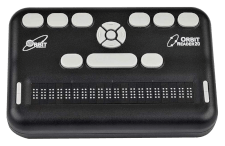Screen Reader
A screen reader is a type of accessibility software utility that helps people with a visual impairment use a computer or mobile device. A screen reader converts on-screen text into spoken audio, braille output on a refreshable braille display, or both. Most operating systems include built-in screen reader software that supports reading out text in webpages, documents, and the system user interface.
While the name "screen reader" may imply software that just reads the screen, most screen-reading software also offers new ways to interact with a computer. Accessibility APIs supported by operating systems allow screen readers to navigate between sections of the screen using keyboard shortcuts and describe the contents of each section. The software can speak the name of a button or menu, let you move between buttons or menus until you find what you need, then allow you to "click" it. The software can also automatically speak aloud notifications and alerts that appear on the screen. Screen readers will also narrate special descriptive text, embedded in images and documents, that doesn't appear on screen at all.
Most screen readers also support special peripherals called refreshable braille displays. These devices include an array of 8-dot braille cells that raise dots to create a line of braille text. Since these cells are refreshable, they constantly change as new text is selected. These displays also include buttons that let you control a computer without moving your hand far away from the line of braille text.
 Test Your Knowledge
Test Your Knowledge